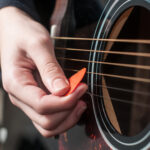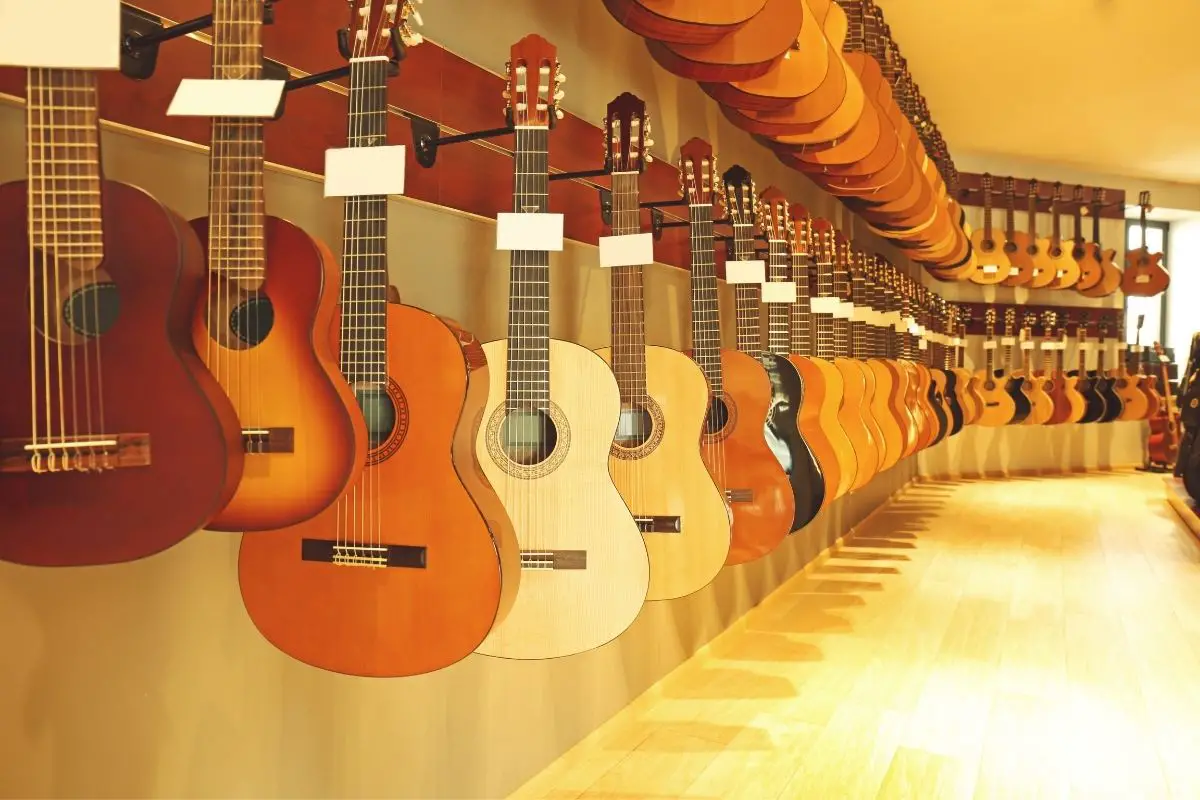Many aspiring guitar players find themselves struggling with finger flexibility and reach, making it difficult to play chords and progress in their musical journey. This common issue can lead to frustration and hinder one’s ability to truly enjoy playing the guitar.
However, with patience, practice, and the right approach, you can overcome these challenges and develop the necessary finger dexterity for playing this wonderful instrument.
The key to improving your finger stretching and dexterity lies in understanding the anatomy of your hands and fingers, and working on targeted exercises that cater to your specific needs. These exercises can include gentle stretches, finger strengthening routines, and strategic approaches to guitar playing.
By incorporating these practices into your daily routine, you can gradually improve your finger flexibility, reach, and strength, resulting in a more enjoyable and seamless guitar playing experience.
Key Takeaways on My Fingers Won’t Stretch to Play Guitar
- Overcoming finger stretching challenges requires patience, practice, and knowledge about hand anatomy.
- Finger-strengthening exercises and technique adaptations can help different hand types play chords more easily.
- Developing proper rest and practice habits can prevent finger pain and injuries while improving guitar skills.
Understanding Guitar Anatomy
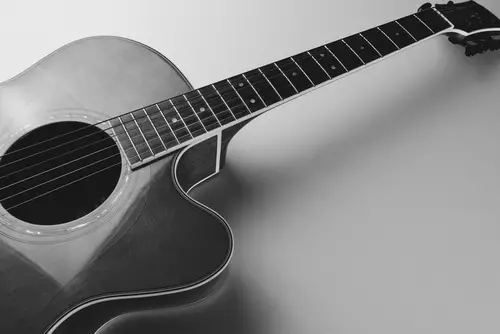
Check out our other popular picks in this category:
- Step-by-Step Guide on How to Play Bass with a Pick
- How to Play Electric Guitar Without an Amp
- How to Play Guitar with Fat Finger
Identifying Guitar Parts
To play guitar comfortably, it’s important to understand the various guitar parts. The main components include the body, neck, and headstock. The body typically houses the soundhole (for acoustic and classical guitars) and the strings’ bridge.
The neck extends from the body and features the fretboard with frets and position markers. The headstock is the uppermost part of the guitar, where the tuning pegs are located. Knowing these parts helps you find the right posture and grip for playing.
Role of Fretboard
The fretboard is an essential part of the guitar, as it is where the player’s fingers press down on the strings to create different notes and chords. It is usually made of wood, such as rosewood or maple, and can have a flat or slightly curved surface.
In a classical guitar, the fretboard is typically wider to accommodate fingerstyle playing. Understanding the fretboard’s role is crucial for guitar students, as it impacts finger positioning, stretching, and overall playability.
Basics of Playing Guitar
Learning Chords and Notes
When beginning to learn how to play the guitar, it’s essential to start with mastering the basic chords and notes. Chords are a group of notes played simultaneously, creating a harmonious sound, while individual notes are the building blocks of music.
As a beginner, one should start with simple chords such as C, G, and D, before progress to more complex ones. To play these chords, practice placing your fingers on the fretboard and applying pressure, after which you can strum the strings with your other hand.
Having a solid foundation in reading and understanding the notes on the guitar’s fretboard is crucial for both chord and melody playing.
For a beginner, it is useful to learn the natural notes – A, B, C, D, E, F, and G – and recognize their positions on the neck of the guitar. With practice and time, playing these notes and chords will become second nature.
Familiarizing with Tabs and Music Theory
Guitar tabs, or tablatures, are a simplified method of reading and playing guitar music. They use numbers and lines to represent frets and strings on the guitar’s fretboard.
Tabs are an accessible way for beginners to learn new songs and techniques quickly, without initially delving deep into music theory.
However, having a basic understanding of music theory is advantageous for any guitar player. It enables you to comprehend the structure and patterns of songs, and eventually create your own music.
Music theory covers fundamental concepts such as tempo, scales, keys, and time signatures. As a newbie, acquiring knowledge about these elements can greatly enhance your guitar playing skills and make learning new pieces a more enjoyable experience.
By dedicating time and effort to mastering chords, notes, tabs, and music theory, one can significantly improve their guitar playing technique and enjoy the process of learning this versatile instrument.
Finger Stretching for Guitar Playing

Introduction to Stretching
Finger stretching is an essential aspect for guitar players as it helps in improving flexibility and dexterity of the fingers, hands, and wrists. A guitarist’s ability to play complex chords and scales largely depends on their finger flexibility.
Stretching exercises not only enhance finger flexibility but also help maintain overall joint health by promoting circulation and strengthening ligaments.
Techniques for Finger Stretching
1. Wrist Circles
Begin by holding your arm straight out in front of you, with your palm facing down. Gently rotate your wrist in circular motions to warm up the surrounding tendons and ligaments. Perform this exercise for 30 seconds in each direction.
2. Finger Extension and Flexion
Hold your hand out in front of you, with your fingers together and your palm facing away. Slowly extend your fingers as far apart as possible, then return them to their original position. Repeat 10-15 times for each hand.
3. Thumb to Finger Touch
In this exercise, touch your thumb to each fingertip in a sequential manner (index to pinky, then back to index). Perform this exercise 10-15 times for each hand to improve your finger dexterity and coordination.
| Finger | Stretch Duration |
| Index | 5 seconds |
| Middle | 5 seconds |
| Ring | 5 seconds |
| Pinky | 5 seconds |
4. Finger Crossovers
Hold your hand up with fingers spread apart. Cross your middle finger over your index finger and your ring finger over your pinky. Return to the original position and repeat the process 10 times for each hand.
Incorporating these finger stretching exercises into your daily routine can lead to increased flexibility in your hands, fingers, and wrists, ultimately improving your overall guitar playing skills.
Regular practice not only keeps the joints healthy but also provides better endurance and control while playing intricate chords and scales.
Dealing with Finger Pain and Injuries

Avoiding Finger Pain
When starting to play the guitar, it’s quite common to experience finger pain. To minimize this discomfort, practice proper hand positioning, maintain a relaxed grip, and regularly stretch your fingers.
It’s also essential to warm up before playing to avoid straining your tendons. Gradually increase the intensity and frequency of practice sessions to give your fingers time to adjust to the new movements, especially if you are experiencing difficulty stretching your pinky and ring finger.
Using lighter strings may also alleviate finger pain, as they require less force to press down.
Understanding Fingertip Injuries
As a new guitarist, fingertip injuries are not uncommon, and understanding them is crucial for recovery and prevention. Common injuries include blisters, calluses, and tendon inflammation. Blisters may form due to continuous friction between your fingertips and the guitar strings.
It’s important not to pop them and instead allow them to heal naturally. Calluses, on the other hand, indicate that your fingers are adapting to the pressure from playing. Make sure to moisturize your hands regularly to minimize discomfort as the skin thickens.
In more severe cases, guitarists can develop tendonitis due to the repetitive motion and strain on their tendons.
If you experience persistent pain or inflammation, it’s essential to consult a healthcare professional and discuss potential treatment options. Proper rest, stretching, and ice will also help in recovery.
Improving Finger Dexterity and Strength
Building Finger Strength
Developing finger strength is essential for guitar players, especially beginners. One simple exercise to build strength is to press each fingertip firmly against a flat surface for 5-10 seconds. This can help improve grip and develop calluses needed for playing guitar.
Another helpful technique is practicing scales and chords with proper hand position. Focus on using the index finger and gradually incorporate other fingers to establish strong muscle memory. Remember, regular practice is key to building finger strength and calluses on fingertips.
Boosting Finger Dexterity
Enhancing finger dexterity is equally important to playing guitar with ease. One effective exercise involves placing all four fingers on a single string, starting with the index finger on the first fret, and then sliding each finger up one fret at a time.
In addition to sliding exercises, alternate finger picking patterns can be beneficial. Switch between using the thumb and index finger or other finger combinations to perform various picking patterns on the strings.
Keep in mind that maintaining a steady rhythm while playing these exercises can help increase dexterity.
Finally, patience and consistent practice are crucial for improving both finger strength and dexterity. Becoming a skilled guitarist takes time, so remain focused and dedicated to your practice routine.
Adapting Guitar Techniques for Different Hand Types
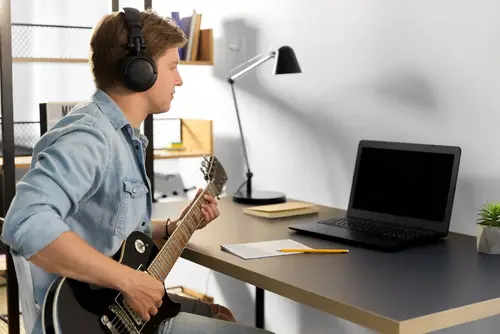
Techniques for Small Hands
For guitarists with small hands, it’s crucial to find comfortable methods to play chords and scales. One way to achieve this is by selecting a guitar with a narrower neck, allowing easier access to frets.
Additionally, small-handed guitarists should focus on proper hand positioning to maximize their reach. Practicing stretching exercises can improve finger mobility and increase the hand’s ability to play more complex chords.
When using a capo, guitarists with small hands can play open chords in higher positions, reducing finger stretch requirements. Fingerpicking can be beneficial as well since it relies on individual finger control rather than full chord shapes.
Adaptations for Thick Fingers
People with thick fingers or larger hands may face challenges while playing intricate chords or solo lines. One possible adaptation is to use the thumb for fretting the lower strings, enabling more room for the fingertips on the fretboard.
Adjusting the hand positioning and angle can also ease the crowding of fingers when playing tight chord shapes.
Maintaining well-trimmed fingernails is vital for guitarists with thicker fingers, as longer nails can inhibit clean fretting and lead to buzzing or muted notes. Finally, consider string gauge and action height adjustments, which can affect the ease of playing for those with larger fingers.
Developing Proper Rest and Practice Habits
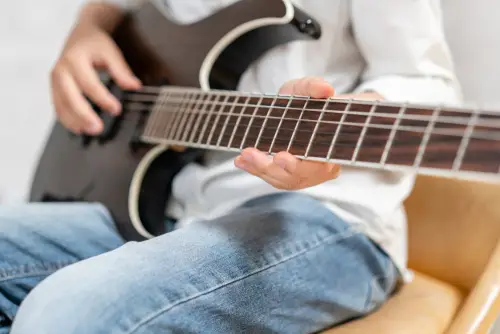
Importance of Rest
It is crucial for guitar players to value the importance of rest in their journey to improve finger dexterity. Rest periods allow the muscles in the fingers to recover, which helps to prevent soreness and painful sensations over time.
Patience is an essential aspect of implementing rest into one’s practice routine. By allowing the fingers to heal and adjust to the demands of playing guitar, individuals can prevent long-term damage and enhance their overall progress.
Practice Techniques and Habits
Developing effective practice habits is essential for guitarists striving to improve their finger flexibility and reach. Some beneficial techniques include:
- Warm-up exercises: By slowly increasing the intensity of practice sessions with finger stretching exercises, guitarists can prepare their hand muscles for more challenging tasks, reducing soreness after practice.
- Short, frequent practice sessions: Shorter, more frequent practice sessions are more effective than longer, sporadic sessions. This gives the fingers time to rest and recover between practices.
- Incorporating rest breaks: Including breaks during practice sessions allows the fingers to relax and prevent the build-up of tension and fatigue.
- Gradual increase in complexity: The complexity of the exercises should increase gradually over time, giving the fingers an opportunity to adjust to new challenges.
Incorporating proper rest and practice habits not only helps to prevent painful and sore fingers, but it also contributes to a more enjoyable and productive learning experience for guitarists of all skill levels.
Advanced Guitar Techniques
Fingerpicking Techniques
Fingerpicking is a popular technique among guitar players that involves using the fingers to pluck individual strings.
The picking hand’s fingers are used to achieve this technique, which can greatly enhance a guitar player’s ability to perform intricate and melodic passages. One way to improve finger stretching and coordination is to practice fingerpicking patterns regularly.
Having a solid foundation in fingerpicking can be achieved through consistent practice, starting with simple exercises and gradually moving to more complex patterns. It is essential to maintain a proper and comfortable hand position to avoid muscle strain and ensure smooth movement of the fingers.
Exploring Strumming and Legato

Strumming is another essential guitar technique that involves playing chords in a rhythmic pattern. This technique is widely used in various music genres, making it crucial for a guitar player to master.
Exploring different strumming patterns helps improve flexibility and coordination, thus allowing the fingers to stretch more comfortably on the fretboard.
Legato is an advanced guitar technique that involves creating a smooth, continuous sound by connecting the notes played on the instrument without muting or changing articulation. This technique, frequently used in lead guitar playing, requires accurate finger motion and strength.
Practicing legato exercises such as hammer-ons, pull-offs, and slides can significantly boost a guitarist’s finger dexterity and stretch.
Regular practice, dedication, and patience are vital elements in the journey of mastering advanced guitar techniques. By focusing on fingerpicking, strumming, and legato, a player will notice improvements in their finger flexibility and their ability to play more intricate pieces on the guitar.
Frequently Asked Questions
How can I improve finger flexibility for guitar playing?
Improving finger flexibility for guitar playing involves regular practice and incorporating specific exercises into your routine. Begin by gently stretching your fingers before playing to warm up the muscles.
Practice basic chord shapes and scales to build strength and flexibility in your fingers. Additionally, try using a finger exerciser or grip strengthener to work on individual finger strength and flexibility.
What are some effective finger exercises for guitar beginners?
Effective finger exercises for guitar beginners include practicing finger independence exercises, such as the “spider” exercise, and working on chord transitions.
Another useful exercise is the “1-2-3-4” finger exercise which involves playing frets one through four in a consecutive manner on all six strings. Practicing hammer-ons and pull-offs can also help strengthen fingers and improve overall coordination.
Do I need long fingers to play guitar chords?
No, long fingers are not necessary to play guitar chords. Many successful guitarists have short fingers and can still play complex chord shapes.
With practice and proper finger placement techniques, any individual can learn to play chords effectively regardless of finger length.
How can I strengthen my fingers for better guitar performance?
To strengthen your fingers for better guitar performance, incorporate strength-building exercises into your practice routine.
Some effective techniques include finger push-ups on the guitar neck, practicing hammer-ons and pull-offs, and using grip strengtheners or finger exercisers. Consistent practice will help increase finger strength over time.
Why is it hard for me to reach frets on the guitar?
Difficulty reaching frets on the guitar can occur for various reasons, including finger length, hand size, guitar neck width, or playing technique.
Guitarists with smaller hands may find it more challenging to reach some frets, particularly on guitars with wide necks. Adjusting the playing angle of the guitar and practicing proper finger placement may help improve reach.
Are there any techniques for playing guitar with small fingers?
Yes, there are techniques for playing guitar with small fingers. These techniques may include using your thumb to fret notes on the lower strings, adjusting guitar neck angle for easier reach, and experimenting with alternate fingerings for chords.
Additionally, consider choosing a guitar with a smaller neck width or shorter scale length to improve playability.

My name is Howard Matthews and I have been playing the guitar since I was knee-high. My parents like to joke that I was pulling the strings even before I was born. In fact, one of my earliest memories is sitting on the couch with my dad’s guitar, wreaking havoc on the chords.
Now, 40 years later, I can attest that I play them much better than I did back then. I have followed in the footsteps of both my parents – much to their delight – and have been the main guitarist in my band for the best part of three decades.
Music has always been my passion, and until recently my life has been so consumed with it that I haven’t had a moment to have a breath (and I wouldn’t have it any other way)!




